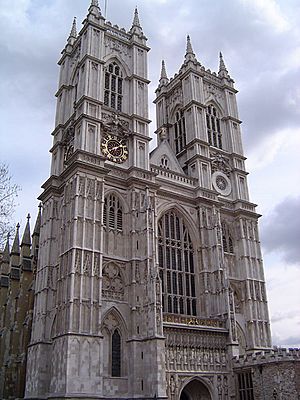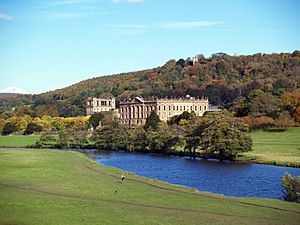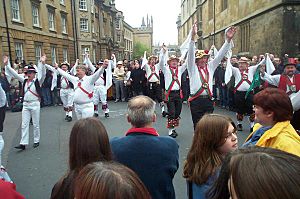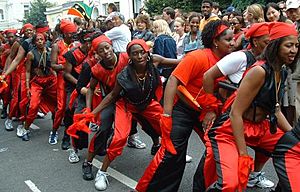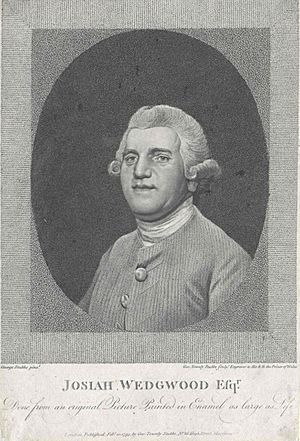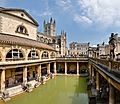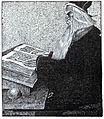Culture of England facts for kids
The culture of England is defined by the idiosyncratic cultural norms of England and the English people. Owing to England's influential position within the United Kingdom it can sometimes be difficult to differentiate English culture from the culture of the United Kingdom as a whole.
However, since Anglo-Saxon times, England has had its own unique culture, apart from Welsh, Scottish or Irish culture.
Contents
Architecture and gardens
English architecture begins with the architecture of the Anglo-Saxons. At least fifty surviving English churches are of Anglo-Saxon origin, although in some cases the Anglo-Saxon part is small and much-altered. All except one timber church are built of stone or brick, and in some cases show evidence of reused Roman work. The architectural character of Anglo-Saxon ecclesiastical buildings ranges from Coptic-influenced architecture in the early period, through Early Christian basilica influenced architecture, to (in the later Anglo-Saxon period) an architecture characterized by pilaster-strips, blank arcading, baluster shafts and triangular-headed openings. Almost no secular work remains above ground.
Following the Norman Conquest Romanesque architecture (known here as Norman architecture) superseded Anglo-Saxon architecture; later there was a period of transition into English Gothic architecture (of which there are three periods, Early English, Decorated, and Perpendicular). In early modern times there was an influence from Renaissance architecture until by the 18th century Gothic forms of architecture had been abandoned and various classical styles were adopted. During the Victorian period Neo-Gothic architecture was preferred for many types of buildings but this did not continue into the 20th century.
Other buildings such as cathedrals and parish churches are associated with a sense of traditional Englishness, as is often the palatial 'stately home'. Many people are interested in the English country house and the rural lifestyle, evidenced by the number of visitors to properties managed by English Heritage and the National Trust.
Landscape gardening as developed by Capability Brown set an international trend for the English garden. Gardening, and visiting gardens, are regarded as typically English pursuits.
English seaside piers
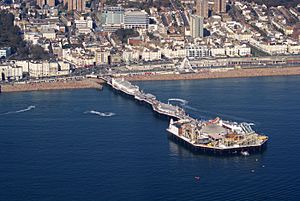
Following the building of the world's first seaside pier in July 1814 in Ryde, Isle of Wight off the south coast of England, the pier became fashionable at seaside resorts in England and Wales during the Victorian era, peaking in the 1860s with 69 being built. Providing a walkway out to sea, the seaside pier is regarded among the finest Victorian architecture, and is an iconic symbol of the British seaside holiday. By 1914, more than 100 piers were located around the UK coast. Today there are approximately 55 seaside piers in the UK.
Art
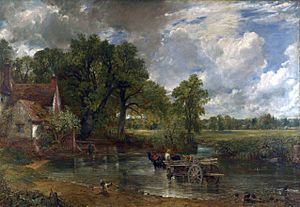
English art was dominated by imported artists throughout much of the Renaissance, but in the 18th century a native tradition became much admired. It is considered to be typified by landscape painting, such as the work of J.M.W. Turner and John Constable. Portraitists like Thomas Gainsborough and Joshua Reynolds are also significant.
Pictorial satirist William Hogarth pioneered Western sequential art, and political illustrations in this style are often referred to as "Hogarthian". Following the work of Hogarth, political cartoons developed in England in the latter part of the 18th century under the direction of James Gillray. Regarded as being one of the two most influential cartoonists (the other being Hogarth), Gillray has been referred to as the father of the political cartoon, with his satirical work calling the king (George III), prime ministers and generals to account.
Cuisine
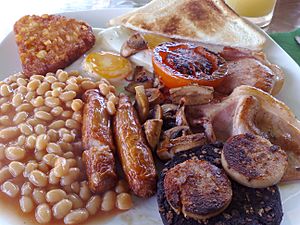
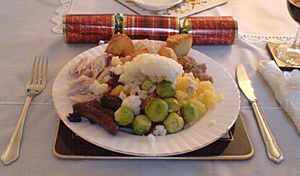
Since the early modern era, the food of England has historically been characterised by its simplicity of approach, honesty of flavour, and a reliance on the high quality of natural produce. This has resulted in a traditional cuisine which tended to avoid strong flavours, such as garlic, and also complex sauces which were commonly associated with Roman Catholic Continental political affiliations. Traditional meals have ancient origins, such as bread and cheese, roasted and stewed meats, meat and game pies, and freshwater and saltwater fish. The 14th-century English cookbook, the Forme of Cury, contains recipes for these, and dates from the royal court of Richard II.
Modern English cuisine is difficult to differentiate from British cuisine as a whole. However, there are some forms of cuisine considered distinctively English. The full English breakfast is a variant of the traditional British fried breakfast. The normal ingredients of a traditional full English breakfast are bacon, eggs, fried or grilled tomatoes, fried mushrooms, fried bread or toast, and sausage, usually served with a cup of coffee or tea. Black pudding can be added as well as fried leftover mashed potatoes called potato cakes or hash browns. A typical English Christmas dinner traditionally consists of turkey which first appeared on the English Christmas dinner table in 1573, and is often accompanied with roast beef or ham, and served with parsley stuffing, gravy, roast potatoes, mashed potatoes and vegetables.
Tea and beer are typical and rather iconic drinks in England, particularly the former. Traditionally, High Tea would be had as a separate meal, instead of afternoon tea which was only found in some classes of society. Cider is produced in the West Country and, more recently, East Anglia and the south of England has seen the reintroduction of vineyards producing white wine on a small scale.
Roast beef is a food traditionally associated with the English; the link was made famous by Henry Fielding's patriotic ballad "The Roast Beef of Old England", and William Hogarth's painting of the same name. Indeed, since the 18th century the phrase "les rosbifs" has been a popular French nickname for the English.
England produces hundreds of regional cheeses, including:
- Cheddar cheese
- Stilton cheese (Leicestershire)
- Wensleydale cheese
- Lancashire cheese
- Dorset Blue Vinney cheese
- Cheshire cheese
- Double Gloucester cheese
- Red Leicester
- Blue cheese
More dishes invented in or distinctive to England include:
- The English crumpet, a form of crumpet; it is distinguished from its Scottish equivalent by its greater thickness
- Muffins, known as 'English muffins' in North America, a form of rounded, yeast-leavened bread
- Lancashire hotpot
- Crumpets
- Mushy peas
- Beef Wellington
- Worcester sauce
- Clotted cream from Devon and Cornwall
- Yorkshire pudding
- Sausage and mash
- Eccles cake (from Eccles, Greater Manchester)
- Cumberland sausage
- Lincolnshire sausage
- Balti, a form of curry invented in Birmingham in the 20th century
- Apple pie
- Banoffee pie
Folklore
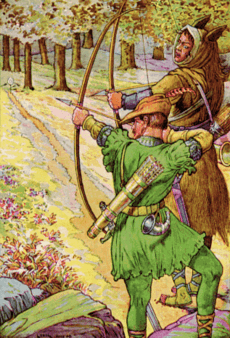
English folklore developed over many centuries. Some of the characters and stories are present all over England, but most belong to specific regions. Common folkloric beings include pixies, giants, elves, bogeymen, trolls, goblins and dwarves. While many legends and folk-customs are thought to be ancient, for instance the tales featuring Offa of Angel and Wayland the Smith, others date from after the Norman invasion; Robin Hood and his Merry Men of Sherwood and their battles with the Sheriff of Nottingham being, perhaps, the best known.
During the High Middle Ages tales originated from Brythonic traditions, notably the Arthurian legend. Deriving from Welsh source; King Arthur, Excalibur and Merlin, while the Jersey poet Wace introduced the Knights of the Round Table. These stories are most centrally brought together within Geoffrey of Monmouth's Historia Regum Britanniae. Another early figure from British tradition, King Cole, may have been based on a real figure from Sub-Roman Britain. Many of the tales and pseudo-histories make up part of the wider Matter of Britain, a collection of shared British folklore.
Some folk figures are based on semi or actual historical people whose story has been passed down centuries; Lady Godiva for instance was said to have ridden naked on horseback through Coventry, Hereward the Wake was a heroic English figure resisting the Norman invasion, Herne the Hunter is an equestrian ghost associated with Windsor Forest and Great Park and Mother Shipton is the archetypal witch. On 5 November people make bonfires, set off fireworks and eat toffee apples in commemoration of the foiling of the Gunpowder Plot centred on Guy Fawkes. The chivalrous bandit, such as Dick Turpin, is a recurring character. There are various national and regional folk activities, participated in to this day, such as Morris dancing, Maypole dancing, Rapper sword in the North East, Long Sword dance in Yorkshire, Mummers Plays, bottle-kicking in Leicestershire, and cheese-rolling at Cooper's Hill. There is no official national costume, but a few are well established such as the Pearly Kings and Queens associated with cockneys, the Royal Guard, the Morris costume and Beefeaters. The utopian vision of a traditional England is sometimes referred to as Merry England.
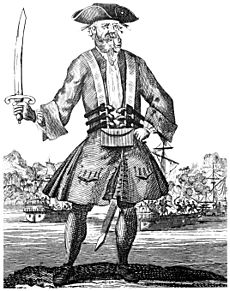
Published in 1724, A General History of the Pyrates by Captain Charles Johnson provided the standard account of the lives of many pirates in the Golden Age. Many famous English pirates from the Golden Age hailed from the West Country in the south west coast of England—the stereotypical West Country "pirate accent" was popularised by West Country native Robert Newton's portrayal of Long John Silver in film. The concept of "walking the plank" was popularised by J. M. Barrie's novel, Peter Pan, where Captain Hook's pirates helped define the archetype. Davy Jones' Locker where sailors or ship's remains are consigned to the bottom of the sea is first recorded by Daniel Defoe in 1726. Johnson's 1724 book gave a mythical status to famous English pirates such as Blackbeard and Calico Jack—Jack is known for his Jolly Roger flag design, a skull with crossed swords.
The Gremlin is part of Royal Air force folklore dating from the 1920s, with gremlin being RAF slang for a mischievous creature that sabotages aircraft, meddling in the plane's equipment. Legendary figures from 19th century London whose tales have been romanticised include Sweeney Todd, the murderous barber of Fleet Street. On 5 November, people in England make bonfires, set off fireworks and eat toffee apples in commemoration of the foiling of Guy Fawkes' Gunpowder Plot, which became an annual event after The Thanksgiving Act of 1606 was passed. Guy Fawkes mask is an emblem for anti-establishment protest groups.
Language
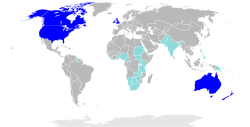
English people traditionally speak the English language, a member of the West Germanic language family. The modern English language evolved from Middle English (the form of language in use by the English people from the 12th to the 15th century); Middle English was influenced lexically by Norman-French, Old French and Latin. In the Middle English period Latin was the language of administration and the nobility spoke Norman French. Middle English was itself derived from Old English; in the northern and eastern parts of England the language of Danish settlers had influenced the language. During its history Modern English has borrowed extensively from other languages. e.g. French, Latin, Dutch and to a lesser extent from many others.
There were once many different dialects of modern English in England - which were recorded in projects such as the English Dialect Dictionary (late 19th century) and the Survey of English Dialects (mid 20th century), but many of these have passed out of common usage as Standard English has become more widespread through education, the media and socio-economic pressures.
Cornish, a Celtic language, is one of three existing Brythonic languages; its usage has been revived in Cornwall. Historically, another Brythonic Celtic language, Cumbric, was spoken in Cumbria in North West England, but it died out in the 11th century although traces of it can still be found in the Cumbrian dialect. Early Modern English began in the late 15th century with the introduction of the printing press to London and the Great Vowel Shift. Through the worldwide influence of the British Empire, English spread around the world from the 17th to mid-20th centuries. Through newspapers, books, the telegraph, the telephone, phonograph records, radio, satellite television, broadcasters (such as the BBC) and the Internet, as well as the post WWII emergence of the United States as a global superpower, English has become the international language of business, science, communication, sports, aviation, and diplomacy.
Surnames
| Rank | Surname | Origin | Percentage |
|---|---|---|---|
| 1 | Smith | England | 1.44 |
| 2 | Jones | England and Wales | 0.75 |
| 3 | Taylor | England and Scotland | 0.59 |
| 4 | Brown | Scotland | 0.56 |
| 5 | Williams | England and Wales | 0.39 |
| 6 | Wilson | Scotland and England | 0.39 |
| 7 | Johnson | England | 0.37 |
| 8 | Davis | Wales | 0.34 |
| 9 | Robinson | England | 0.32 |
| 10 | Wright | England | 0.32 |
| 11 | Thompson | England | 0.31 |
| 12 | Evans | Wales | 0.30 |
| 13 | Walker | England | 0.30 |
| 14 | White | England | 0.30 |
| 15 | Roberts | England | 0.28 |
| 16 | Green | England | 0.28 |
| 17 | Hall | England | 0.28 |
| 18 | Wood | England and Scotland | 0.27 |
| 19 | Jackson | England and Scotland | 0.27 |
| 20 | Clarke | England | 0.26 |
Literature

English literature begins with Anglo-Saxon literature, which was written in Old English. For many years, Latin and French were the preferred literary languages of England, but in the medieval period there was a flourishing of literature in Middle English; Geoffrey Chaucer is the most famous writer of this period. The Elizabethan era is sometimes described as the golden age of English literature, as numerous great poets were writing in English, and the Elizabethan theatre produced William Shakespeare, often considered the English national poet.
Due to the expansion of English into a world language during the British Empire, literature is now written in English across the world. Writers often associated with England or for expressing Englishness include Shakespeare (who produced two tetralogies of history plays about the English kings), Jane Austen, Arnold Bennett, and Rupert Brooke (whose poem "Grantchester" is often considered quintessentially English). Other writers are associated with specific regions of England; these include Charles Dickens (London), Thomas Hardy (Wessex), A. E. Housman (Shropshire), and the Lake Poets (the Lake District).
In the lighter vein, Agatha Christie's mystery novels are outsold only by Shakespeare and The Bible. Described as "perhaps the 20th century's best chronicler of English culture", the non-fiction works of George Orwell include The Road to Wigan Pier (1937), documenting his experience of working class life in the north of England. Orwell's eleven rules for making tea appear in his essay "A Nice Cup of Tea", which was published in the London Evening Standard on 12 January 1946.
In 2003 the BBC carried out a UK survey entitled The Big Read in order to find the "nation's best-loved novel" of all time, with works by English novelists J. R. R. Tolkien, Jane Austen, Philip Pullman, Douglas Adams and J. K. Rowling making up the top five on the list.
Music
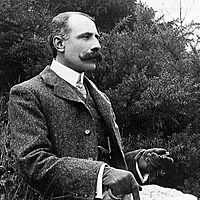

England has a long and rich musical history. The United Kingdom has, like most European countries, undergone a roots revival in the last half of the 20th century. English music has been an instrumental and leading part of this phenomenon, which peaked at the end of the 1960s and into the 1970s.
The achievements of the Anglican choral tradition following on from 16th-century composers such as Thomas Tallis, John Taverner and William Byrd have tended to overshadow instrumental composition. The semi-operatic innovations of Henry Purcell did not lead to a native operatic tradition, but George Frideric Handel found important royal patrons and enthusiastic public support in England. One of Handel's four Coronation Anthems, Zadok the Priest (1727), composed for the coronation of George II, has been performed at every subsequent British coronation, traditionally during the sovereign's anointing. The rapturous receptions afforded by audiences to visiting musical celebrities such as Haydn often contrasted with the lack of recognition for home-grown talent. However, the emergence of figures such as Edward Elgar and Arthur Sullivan in the 19th century showed a new vitality in English music. In the 20th century, Benjamin Britten and Michael Tippett emerged as internationally recognised opera composers, and Ralph Vaughan Williams and others collected English folk tunes and adapted them to the concert hall. Cecil Sharp was a leading figure in the English folk revival.
Finally, a new trend emerged from Liverpool in 1962. The Beatles became the most popular musicians of their time, and in the composing duo of John Lennon and Paul McCartney, popularized the concept of the self-contained music act. Before the Beatles, very few popular singers composed the tunes they performed. The "Fab Four" opened the doors for other English acts such as The Rolling Stones, Led Zeppelin, Pink Floyd, Cream, The Kinks, The Who, Eric Clapton, David Bowie, Queen, Elton John, The Hollies, Black Sabbath, Deep Purple, Genesis, Dire Straits, Iron Maiden, The Police to the globe.
The Sex Pistols and The Clash were pioneers of punk rock. Some of England's leading contemporary artists include George Michael, Sting, Seal, Rod Stewart, The Smiths, The Spice Girls, Oasis, Blur, Radiohead, The Cure, Depeche Mode, Def Leppard, One Direction, Robbie Williams, Coldplay, Muse, Mumford & Sons, Amy Winehouse, Adele, Ellie Goulding, Sam Smith, Rita Ora and Ed Sheeran.
Cinema
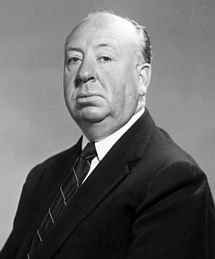
England (and the UK as a whole) has had a considerable influence on the history of the cinema, producing some of the greatest actors, directors and motion pictures of all time, including Alfred Hitchcock, Charlie Chaplin, David Lean, Laurence Olivier, Vivien Leigh, John Gielgud, Peter Sellers, Julie Andrews, Michael Caine, Gary Oldman, Helen Mirren, Kate Winslet and Daniel Day-Lewis. Hitchcock and Lean are among the most critically acclaimed of all-time. Hitchcock's first thriller, The Lodger: A Story of the London Fog (1926), helped shape the thriller genre in film, while his 1929 film, Blackmail, is often regarded as the first British sound feature film.
Major film studios in England include Pinewood, Elstree and Shepperton. Some of the most commercially successful films of all time have been produced in England, including two of the highest-grossing film franchises (Harry Potter and James Bond). Ealing Studios in London has a claim to being the oldest continuously working film studio in the world. Famous for recording many motion picture film scores, the London Symphony Orchestra first performed film music in 1935.
The BFI Top 100 British films includes Monty Python's Life of Brian (1979), a film regularly voted the funniest of all time by the UK public. English producers are also active in international co-productions and English actors, directors and crew feature regularly in American films. Ridley Scott was among a group of English filmmakers, including Tony Scott, Alan Parker, Hugh Hudson and Adrian Lyne, who emerged from making 1970s UK television commercials. The UK film council ranked David Yates, Christopher Nolan, Mike Newell, Ridley Scott and Paul Greengrass the five most commercially successful English directors since 2001. Other contemporary English directors include Sam Mendes, Guy Ritchie and Steve McQueen. Current actors include Tom Hardy, Daniel Craig, Benedict Cumberbatch and Emma Watson. Acclaimed for his motion capture work, Andy Serkis opened The Imaginarium Studios in London in 2011. The visual effects company Framestore in London has produced some of the most critically acclaimed special effects in modern film. Many successful Hollywood films have been based on English people, stories or events. The 'English Cycle' of Disney animated films include Alice in Wonderland, The Jungle Book, Robin Hood and Winnie the Pooh.
Performing arts
Large outdoor music festivals in the summer and autumn are popular, such as Glastonbury, V Festival, Reading and Leeds Festivals. The UK was at the forefront of the illegal, free rave movement from the late 1980s, which led to pan-European culture of teknivals mirrored on the UK free festival movement and associated travelling lifestyle. The most prominent opera house in England is the Royal Opera House at Covent Gardens. The Proms, a season of orchestral classical music concerts held at the Royal Albert Hall, is a major cultural event held annually. The Royal Ballet is one of the world's foremost classical ballet companies, its reputation built on two prominent figures of 20th century dance, prima ballerina Margot Fonteyn and choreographer Frederick Ashton.

A staple of British seaside culture, the quarrelsome couple Punch and Judy made their first recorded appearance in Covent Garden, London in 1662. The various episodes of Punch and Judy are performed in the spirit of outrageous comedy — often provoking shocked laughter — and are dominated by the anarchic clowning of Mr. Punch. Regarded as British cultural icons, they appeared at a significant period in British history, with Glyn Edwards stating: "[Pulcinella] went down particularly well with Restoration British audiences, fun-starved after years of Puritanism. We soon changed Punch's name, transformed him from a marionette to a hand puppet, and he became, really, a spirit of Britain - a subversive maverick who defies authority, a kind of puppet equivalent to our political cartoons."
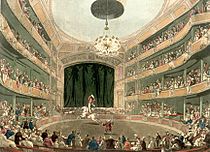
The circus is a traditional form of entertainment in the UK. Chipperfield's Circus dates back more than 300 years in Britain, making it one of the oldest family circus dynasties. Philip Astley is regarded as the father of the modern circus. Following his invention of the circus ring in 1768, Astley's Amphitheatre opened in London in 1773. As an equestrian master Astley had a skill for trick horse-riding, and when he added tumblers, tightrope-walkers, jugglers, performing dogs, and a clown to fill time between his own demonstrations – the modern circus was born. The Hughes Royal Circus was popular in London in the 1780s. Pablo Fanque's Circus Royal, among the most popular circuses of Victorian England, showcased William Kite, which inspired John Lennon to write Being for the Benefit of Mr. Kite! on The Beatles' album, Sgt. Pepper's Lonely Hearts Club Band. Joseph Grimaldi, the most celebrated of English clowns, is considered the father of modern clowning.
The Notting Hill Carnival is an annual event that has taken place on the streets of Notting Hill, London since 1966. Led by the British African-Caribbean community, the carnival has attracted around one million people, making it Britain's biggest street festival and one of the largest in the world. In 2006 the public voted the carnival onto the list of icons of England.
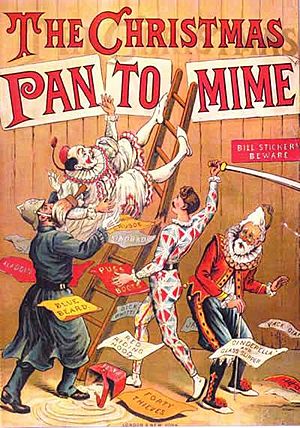
Pantomime (often referred to as "panto") is a British musical comedy stage production, designed for family entertainment. It is performed in theatres throughout the UK during the Christmas and New Year season. The art originated in the 18th century with John Weaver, a dance master and choreographer at the Theatre Royal, Drury Lane in London. In 19th century England it acquired its present form, which includes songs, slapstick comedy and dancing, employing gender-crossing actors, combining topical humour with a story loosely based on a well-known fairy tale. It is a participatory form of theatre, in which the audience sing along with parts of the music and shout out phrases to the performers, such as "It's behind you".
Music hall is a type of British theatrical entertainment popular from the early Victorian era to the mid 20th century. The precursor to variety shows of today, music hall involved a mixture of popular songs, comedy, speciality acts and variety entertainment. British performers who honed their skills at pantomime and music hall sketches include Charlie Chaplin, Stan Laurel, George Formby, Gracie Fields, Dan Leno, Gertrude Lawrence and Harry Champion. British music hall comedian and theatre impresario Fred Karno developed a form of sketch comedy without dialogue in the 1890s, and Chaplin and Laurel were among the music hall comedians who worked for him. A leading film producer stated; "Fred Karno is not only a genius, he is the man who originated slapstick comedy. We in Hollywood owe much to him."
Philosophy
English philosophers include Francis Bacon, Sir Thomas More, John Locke, Thomas Hobbes, Thomas Paine, Jeremy Bentham, John Stuart Mill and Bertrand Russell.
Religion
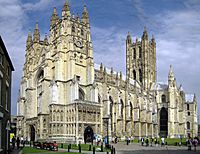
In England, Christianity became the most practiced religion many centuries ago. Polytheistic religions, often referred to as paganism, were practised before Christianity took hold. These religions include Celtic polytheism, Norse paganism, Roman polytheism, and others. Some were introduced by the Anglo-Saxons, who had their origins in ancient Germanic tribes.
Christianity was first introduced through the Romans. According to legends the introduction of Christianity to England was due to Joseph of Arimathea who came to Glastonbury; there is also a legend of Saint Lucius. Archaeological evidence for Christian communities begins to appear in the 3rd and 4th centuries. The Romano-British population after the withdrawal of the Roman legions was mostly Christian.
Christianity was reintroduced into England by missionaries from Scotland and from Continental Europe: the era of St Augustine (the first Archbishop of Canterbury) and the Celtic Christian missionaries in the north (notably St. Aidan and St. Cuthbert who came from Scotland) begins in 597 AD. The Synod of Whitby in 664 ultimately led to the English Church being fully part of Roman Catholicism. Early English Christian documents from this time include the 7th century illuminated Lindisfarne Gospels and the historical accounts written by the Venerable Bede. The Durham Gospels is a Gospel book produced at Lindisfarne.
In 1536, the Church in England split from Rome over the issue of the divorce (technically, the marriage annulment) of King Henry VIII from Catherine of Aragon. The split led to the emergence of a separate ecclesiastical authority. Later the influence of the Reformation resulted in the Church of England adopting its distinctive reformed Catholic position known as Anglicanism which maintains episcopacy while adopting a Lutheran theology. For more detail of this period see the following article: Timeline of the English Reformation.
Today, the Church of England is the established church in England. It regards itself as in continuity with the pre-Reformation state Catholic church (something the Roman Catholic Church does not accept) and has been a distinct Anglican church since the settlement under Elizabeth I (with some disruption during the 17th-century Commonwealth period). The British Monarch is formally Supreme Governor of the Church of England. Its spiritual leader is the Archbishop of Canterbury, who is regarded by convention as the head of the worldwide Anglican Communion. In practice the Church of England is governed by the General Synod, under the authority of Parliament. The Church of England's mission to spread the Gospel has seen the establishment of many churches in the Anglican Communion throughout the world particularly in the Commonwealth of Nations.
A strong tradition of Methodism developed from the 18th century onward. The Methodist revival was started in England by a group of men including John Wesley and his younger brother Charles as a movement within the Church of England; it developed as a separate denomination after John Wesley's death. Other non-conformist Protestant traditions were also established in England.
Saint George is recognised as the patron saint of England. Before Edward III, St Edmund was recognised as England's patron saint, and the flag of England consists of the cross of St George. However, Saint Alban is venerated by some as England's first Christian martyr.
Celebration of Christmas
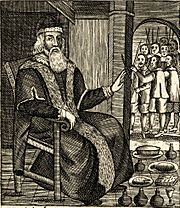
In 17th-century England, the Puritans condemned the celebration of Christmas. In contrast, the Anglican Church "pressed for a more elaborate observance of feasts, penitential seasons, and saints' days. The calendar reform became a major point of tension between the Anglicans and Puritans." The Catholic Church also responded, promoting the festival in a more religiously oriented form. King Charles I of England directed his noblemen and gentry to return to their landed estates in midwinter to keep up their old-style Christmas generosity. Following the Parliamentarian victory over Charles I during the English Civil War, Puritan rulers banned Christmas in 1647.
Protests followed as pro-Christmas rioting broke out in several cities and for weeks Canterbury was controlled by the rioters, who decorated doorways with holly and shouted royalist slogans. The book, The Vindication of Christmas (London, 1652), argued against the Puritans, and makes note of Old English Christmas traditions, dinner, roast apples on the fire, card playing, dances with "plow-boys" and "maidservants", old Father Christmas and carol singing. The Restoration of King Charles II in 1660 ended the ban. Following the Restoration, Poor Robin's Almanack contained the lines: "Now thanks to God for Charles return, / Whose absence made old Christmas mourn. / For then we scarcely did it know, / Whether it Christmas were or no."
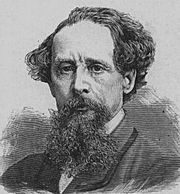
In the early 19th century, writers imagined Tudor Christmas as a time of heartfelt celebration. In 1843, Charles Dickens wrote the novel A Christmas Carol that helped revive the "spirit" of Christmas and seasonal merriment. Dickens sought to construct Christmas as a family-centred festival of generosity, in contrast to the community-based and church-centred observations, the observance of which had dwindled during the late 18th century and early 19th century. Dickens influenced many aspects of Christmas that are celebrated today in Western culture, such as family gatherings, seasonal food and drink, dancing, games, and a festive generosity of spirit. A prominent phrase from the tale, "Merry Christmas", was popularized following the appearance of the story. The term Scrooge became a synonym for miser, with "Bah! Humbug!" dismissive of the festive spirit.
The revival of the Christmas Carol began with William Sandys's Christmas Carols Ancient and Modern (1833), with the first appearance in print of "The First Noel", "I Saw Three Ships", "Hark the Herald Angels Sing" and "God Rest Ye Merry, Gentlemen". In 1843 the first commercial Christmas card was produced by Henry Cole leading to the exchange of festive greeting cards among the public.
Historical markers: blue plaques
A blue plaque, the oldest historical marker scheme in the world, is a permanent sign installed in a public place in the UK to commemorate a link between that location and a famous person or event. The scheme was the brainchild of politician William Ewart in 1863 and was initiated in 1866. It was formally established by the Society of Arts in 1867, and since 1986 has been run by English Heritage.
The first plaque was unveiled in 1867 to commemorate Lord Byron at his birthplace, 24 Holles Street, Cavendish Square, London. Examples that commemorate events include John Logie Baird's first demonstration of the television at 22 Frith Street, Westminster, W1, London, and the first sub 4-minute mile run by Roger Bannister on 6 May 1954 at Oxford University's Iffley Road Track.
Science
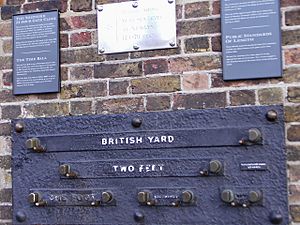
England and Scotland were leading centres of the Scientific Revolution from the 17th century. The English have played a significant role in the development of science and engineering. Prominent individuals have included Roger Bacon, Francis Bacon, William Harvey, Robert Hooke, Isaac Newton, Edward Jenner, Henry Cavendish, Isambard Kingdom Brunel, Francis Crick, Charles Babbage, Abraham Darby, Michael Faraday, Charles Darwin, James Chadwick, Joseph Swan, Barnes Wallis, Alan Turing, Frank Whittle, Tim Berners-Lee and Stephen Hawking. It is home to the Royal Institution, the Royal Society, the Greenwich Observatory and its associated meridian.
Industrial Revolution
The Industrial Revolution began in England due to the social, economic and political changes in the previous centuries in Britain. Whereas absolute monarchy stayed the normal form of power execution through most parts of Europe, institutions ensured property rights and political safety to British people after the Glorious Revolution of 1688. Aided by these legal and cultural foundations, an entrepreneurial spirit and consumer revolution drove industrialisation in Britain. Geographical and natural resource advantages of Great Britain also contributed, with the country's extensive coast lines and many navigable rivers in an age where water was the easiest means of transportation. Britain also had high quality coal. According to British historian Jeremy Black, "an unprecedented explosion of new ideas, and new technological inventions, transformed our use of energy, creating an increasingly industrial and urbanised country. Roads, railways and canals were built. Great cities appeared. Scores of factories and mills sprang up. Our landscape would never be the same again. It was a revolution that transformed not only the country, but the world itself."
The 18th century entrepreneur Josiah Wedgwood is credited with the industrialisation of the manufacture of pottery. Meeting the demands of the consumer revolution and growth in wealth of the middle classes in Britain, Wedgwood created goods such as tableware, which was starting to become a common feature on dining tables. Credited as the inventor of modern marketing, Wedgwood pioneered direct mail, money back guarantees, travelling salesmen, carrying pattern boxes for display, self-service, free delivery, buy one get one free, and illustrated catalogues. Described as "natural capitalists" by the BBC, dynasties of Quakers were successful in business matters which contributed the Industrial Revolution. This included ironmaking by Abraham Darby I and his family; banking, including Lloyds Banking Group (founded by Sampson Lloyd), Barclays PLC, Backhouse's Bank and Gurney's Bank; life assurance (Friends Provident); pharmaceuticals (Allen & Hanburys); the big three British chocolate companies Cadbury, Fry's and Rowntree); biscuit manufacturing (Huntley & Palmers); match manufacture (Bryant and May) and shoe manufacturing (Clarks). With his role in the marketing and manufacturing of James Watt's steam engine, and invention of modern coinage, Matthew Boulton is regarded as one of the most influential entrepreneurs in history.
Other important English engineers and inventors in the Industrial Revolution include; George Stephenson, Richard Arkwright, Henry Maudslay and Isambard Kingdom Brunel. England has the oldest railway networks in the world, with the Stockton and Darlington Railway, opened in 1825, the first public railway to use steam locomotives. Opened in 1863, London Underground is the world's first underground railway. Known as the "Father of Railways", Stephenson's rail gauge of 4 feet 8+1⁄2 inches (1,435 mm) is the standard gauge for most of the world's railways. Henry Maudslay's most influential invention was the screw-cutting lathe, a machine which created uniformity in screws and allowed for the application of interchangeable parts (a prerequisite for mass production): it was a revolutionary development necessary for the Industrial Revolution. Brunel created the Great Western Railway, as well as famous steamships including the SS Great Britain, the first propeller-driven ocean-going iron ship, and SS Great Eastern which laid the first lasting transatlantic telegraph cable.
Sport and leisure
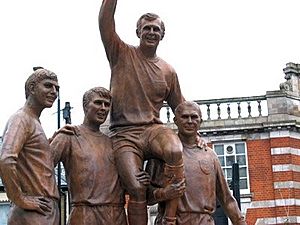
There are many sports which have been codified by the English, and then spread worldwide, including badminton, cricket, croquet, football, field hockey, lawn tennis, rugby league, rugby union, table tennis and thoroughbred horse racing. In the late 18th century, the English game of rounders was transported to the American Colonies, where it evolved into baseball. Association football, cricket, rugby union and rugby league are considered to be the national sports of England.
The rules of football were first drafted in 1863 by Ebenezer Cobb Morley, and England has the oldest football clubs in the world. Recognised by FIFA as the birthplace of club football, Sheffield F.C., founded in 1857, is the world's oldest football club. The first ever international football match was between England and Scotland in 1872. Referred to by the sport's governing body FIFA as the "home of football", England hosted the 1966 FIFA World Cup, and won the tournament. With a British television audience of 32.3 million, the 1966 final is the most watched television event ever in the United Kingdom. The English Barclays Premier League is the most-watched football league in the world. Its biggest clubs include Manchester United, Liverpool, Arsenal, Chelsea, Tottenham Hotspur and Manchester City. The current champions are Leicester City who were 5,000-1 outsiders at the start of the season. By some measures it was the greatest sporting upset ever: multiple bookmakers had never paid out at such long odds for any sport. As is the case throughout the UK, football in England is renowned for the intense rivalries between clubs and the passion of the supporters, which includes a tradition of football chants, such as, "You're Not Singing Any More" (or its variant "We Can See You Sneaking Out!"), sung by jubilant fans towards the opposition fans who have gone silent (or left early).
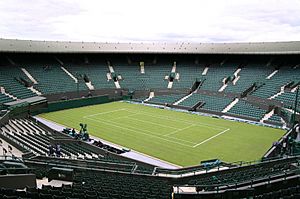
The modern game of tennis originated in Birmingham, England, in the 1860s, and after its creation, tennis spread throughout the upper-class English-speaking population, before spreading around the world. Major Walter Clopton Wingfield is credited as being a pioneer of the game. The world's oldest tennis tournament, the Wimbledon championships, first occurred in 1877, and today the event takes place over two weeks in late June and early July. Created in the Tudor period in the court of Henry VIII, the English dessert Strawberries and cream is synonymous with the British summer, and is famously consumed at Wimbledon.

England, and other countries in the United Kingdom, compete as a separate nations in some international sporting events, especially in football, cricket, rugby league and rugby union. The England cricket team actually represents England and Wales. However, in the Olympic Games, England competes as part of the Great Britain team. English supporters are now more likely to carry the Cross of Saint George flag than the British Union Flag.
Football maintains a consistent popularity across the country and is often indicative of trends across wider culture in England, such as in clothing and music. Different sports directly represent the different social classes within England. Rugby league, for instance, was traditionally associated with the old mill towns of north-west England, whereas cricket and rugby union have their origins in the private schools of the 18th and 19th centuries respectively.
Symbols
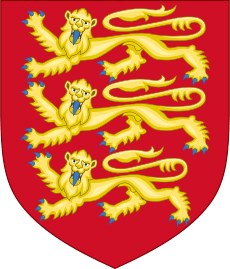
The English use as their national flag the red cross of St George. St George's Day in England is marked as the day of the patron saint, and is also celebrated as the day of birth and death of William Shakespeare.
In 1198, King Richard the Lionheart introduced the coat of arms of England, depicting "three lions". The three lions form the basis of several emblems of English national sports teams, such as the England national football team, and the English national cricket team (though in blue rather than gold). The English oak and the Tudor rose are also English symbols, the latter of which is (although more modernised) used by the England national rugby union team.
England has no official anthem; however, the United Kingdom's "God Save the Queen" is commonly used. Other songs are sometimes used, including "Land of Hope and Glory" (used as England's anthem in the Commonwealth Games), "Jerusalem", "Rule Britannia", and "I Vow to Thee, My Country". Moves by certain groups are encouraging adoption of an official English anthem following similar occurrences in Scotland and Wales.
Images for kids
-
Durham Cathedral, dating from 1093.
-
Large miniature of George Clifford, 3rd Earl of Cumberland by Nicholas Hilliard, c. 1590, after his appointment as the Queen's Champion, in tilting attire with the Queen's glove as her favour pinned to his hat.
-
Flatford Mill ('Scene on a Navigable River') by John Constable, c1816
-
King's College in Cambridge is regarded as one of the greatest examples of late English Gothic architecture. It has the world's largest fan vault, while the chapel's stained-glass windows and wooden chancel screen are considered some of the finest from their era.
-
The Roman Baths in Bath; a temple was constructed on the site between 60–70CE in the first few decades of Roman Britain. It is a lasting monument from Roman Britain.
-
The Royal College of Music is a conservatoire established by royal charter in 1882, located in South Kensington, London.
-
Christopher Lee (seen here as Dracula in 1958) starred in many of Hammer's British horror films.
-
National performing arts are held annually at the Royal Albert Hall, as well as The Proms during the summer.
-
The wizard Merlin features as a character in many works of fiction, including the BBC series Merlin.
-
Canterbury Cathedral is the seat of the Primate of All England, the Archbishop of Canterbury, the most senior bishop of the Church of England (it was the property of the Roman Catholic Church before the English Reformation)
-
The Lady Chapel of Wells Cathedral
-
Charles Dickens' 1843 novella A Christmas Carol played a major role in reviving the "spirit" of Christmas and seasonal goodwill
-
Sir Isaac Newton, 1689. Regarded as one of the most influential scientists of all time and as a key figure in the Scientific Revolution.
-
King Charles II, a patron of the arts and sciences, supported the Royal Society, a scientific group whose early members included Robert Hooke, Robert Boyle and Sir Isaac Newton.
-
Francis Bacon in a portrait by Pourbus the Younger, (1617). His works are seen as developing the scientific method and remained highly influential through the Scientific revolution.
-
England playing Australia at Lord's Cricket Ground in the 2009 Ashes series. After winning the 2019 Cricket World Cup, England became the first country to win the World Cups in football, rugby union and cricket.
-
First played in 1877, the Wimbledon Championships is the oldest tennis tournament in the world.
-
King Alfred the Great statue in Winchester, Hampshire. The 9th-century English king encouraged education in his kingdom, and proposed that primary education be taught in English, with those wishing to advance to holy orders to continue their studies in Latin.
See also
 In Spanish: Cultura de Inglaterra para niños
In Spanish: Cultura de Inglaterra para niños


